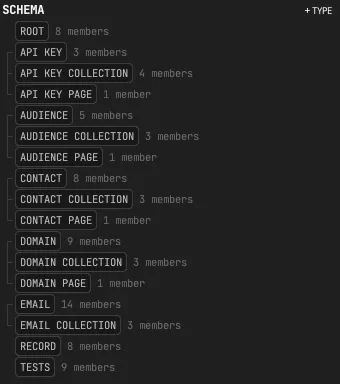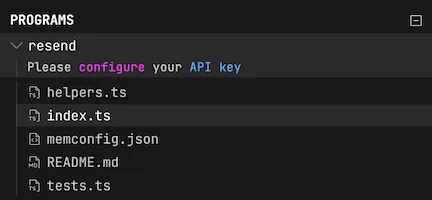Integrations
This guide covers Membrane integrations with third-party APIs. Our packages docs include a section on integrations. If you haven’t yet, read that first to understand what packages are before digging into the how in this guide. After reading, you’ll be ready to consume integrations and even create your own.
We have Membrane packages for popular APIs like membrane/github and membrane/slack. Check out the full list here. Note that integrations don’t have to cover an entire API. They can expose only a subset of an API, like our membrane/stripe-subscriptions package does.
For this guide, we’ll walk through the membrane/resend program. Resend provides a modern email API for developers. For more details about their API, check out Resend’s documentation. We’ll demonstrate how to:
- Create an interface for the API that uses Membrane state to store the API key
- Structure your code using common patterns (Collections, Resources, grefs)
- Follow consistent design principles and best practices
Anatomy of an integration
Section titled “Anatomy of an integration”File Organization
Section titled “File Organization”A typical API integration should have this structure:
resend/├── index.ts # Main code and exports├── helpers.ts # Fetch helper and utilities├── tests.ts # Test cases├── memconfig.json # Schema└── README.md # DocumentationSchema
Section titled “Schema”Before we dive into the code, let’s take a look at the program schema.
A program’s schema is defined in memconfig.json. You generally won’t edit it by hand (although you can). Instead, you’ll use the SCHEMA editor on the right sidebar.

The schema for a program defines the shape of its graph. When writing an integration, the schema should match the API as logically as possible.
Configuration
Section titled “Configuration”Every integration should have basic configuration and status checks. Here’s how we implement this for Resend:
import { state } from "membrane";
// Use Membrane's state to persist the API key between program runsexport function status() { return state.API_KEY ? "Configured" : "Please [configure](:configure) your [API key](https://resend.com/api-keys)";}
export async function configure({ apiKey }: { apiKey: string }) { if (!apiKey) { throw new Error("Please provide a valid API key"); } state.API_KEY = apiKey;}The [label](:action) syntax in the status function renders an invocable action from the left sidebar, and the [label](url) markdown syntax creates clickable links.

Those functions for the status field and configure action live in a helpers.ts file along with other base code.
helper.ts
Section titled “helper.ts”As a convention, utility functions live in helpers.ts. For this package, we have an api function that calls fetch with the requisite authentication headers and the specified method, path, query string, body. It also handles parsing the response as JSON when appropriate.
// helpers.tsconst BASE_URL = "https://api.resend.com";
type Method = "GET" | "POST" | "PUT" | "DELETE" | "PATCH";
export async function api( method: Method, path: string, query?: Record<string, any>, body?: any) { const url = new URL(`${BASE_URL}/${path}`);
// Add query parameters if they exist if (query) { Object.entries(query).forEach(([key, value]) => { if (value !== undefined && value !== null) { url.searchParams.append(key, String(value)); } }); }
const headers = { Authorization: `Bearer ${state.API_KEY}`, "Content-Type": "application/json", };
const response = await fetch(url.toString(), { method, headers, body, });
if (!response.ok) { throw new Error(`API error: ${response.status} ${response.statusText}`); }
const contentType = response.headers.get("content-type"); if (contentType && contentType.includes("application/json")) { return response.json(); } else { return response.text(); }}Most integrations will need a similar function to make the actual HTTP requests to the API. Response handling will vary by API, of course. It might make sense to always return JSON in some cases or return different content-types based on the response in others.
Helper functions are imported in the program’s index.ts entry file.
Root object
Section titled “Root object”Every program (not just integrations) has a Root type in its schema which defines the top-level structure of the program’s graph. Here it is for Resend:

To expose that functionality via the Membrane graph, the program exports a Root object with field resolvers:
// index.tsimport { root } from "membrane"import { status, configure } from "./helpers"
export const Root = { // Status field for configuration status,
// Configuration action configure,
// Collection fields emails: () => ({}), // EmailCollection domains: () => ({}), // DomainCollection apiKeys: () => ({}), // ApiKeyCollection, audiences: () => ({}), // AudienceCollection, contacts: () => ({}), // ContactCollection,
// Test fields tests: () => ({}),}Instead of exporting a Root object, you can also export each resolver at the top level of the file.
Note that the resolvers don’t do much—they simply return an empty object. This tells the GraphQL executor to continue the query by invoking the resolvers in EmailCollection and DomainCollection respectively (more on that below).
Resources, collections, and pages
Section titled “Resources, collections, and pages”Integrations organize code around key resources. Resources are entities or objects, e.g. an Email or Domain in the case of Resend. Resources handle item-specific operations like updating or deleting, while collections handle operations like listing/paginating and creating resources.
This Resource-Collection-Page pattern in Membrane provides a consistent interface where:
- Collections have fields
one()for getting a single resource andpage()for listing multiple, plus other collection-level operations likecreate()orsearch() - Resources implement item-specific operations like
update()anddelete()
Collection and resource objects are typically exported from the top level of a program’s index.ts file.
Email collection
Section titled “Email collection”Collections typically implement one() for getting single resources and other methods for creating new resources:
// index.tsexport const EmailCollection = { // Get a single email by ID async one({ id }: { id: string }) { const data = await api("GET", `emails/${id}`); return { ...data }; },
// Send a new email async send(args: { from: string; to: string[]; subject: string; html?: string; text?: string; }) { const data = await api("POST", "emails", undefined, args); return { ...data }; }};Email resource
Section titled “Email resource”Resources handle operations specific to a single item. They must implement a gref for referencing (more on this below):
// index.tsexport const Email = { // Create a reference to this email gref: function (_, { obj }) { return root.emails.one({ id: obj.id }); },
// Update email (e.g., reschedule) async update(args: { scheduled_at: string }, { self }) { const { id } = self.$argsAt(root.emails.one); return api("PATCH", `emails/${id}`, undefined, args); },
// Cancel a scheduled email async cancel(_, { self }) { const { id } = self.$argsAt(root.emails.one); return api("POST", `emails/${id}/cancel`); }};Domain collection (with pagination)
Section titled “Domain collection (with pagination)”For resources that support listing, collections should implement a page() function for pagination:
// index.tsexport const DomainCollection = { // Get a single domain async one({ id }: { id: string }) { return await api("GET", `domains/${id}`); },
// List domains with pagination async page() { const result = await api("GET", "domains"); return { items: result.data }; },
// Create a new domain async create(args: { name: string; region?: string }) { return await api("POST", "domains", undefined, args); }};Graph references (grefs)
Section titled “Graph references (grefs)”In Membrane, grefs (graph references) create a way to reference and track specific resources across your graph. Every resource should implement a gref function that returns a unique, consistent path to that resource.
Think of a gref like a URL - it’s a way to point to a specific resource that can be stored, passed around, and used later. For example:
export const Email = { // This creates references like: // resend:emails.one(id:"12345") gref: function (_, { obj }) { return root.emails.one({ id: obj.id }) },}Grefs serve several important purposes:
- Resource identity: They provide a standardized way to reference specific resources
- Resource lookups: Programs can use grefs to consistently find and access resources
- Cross-program communication: Programs can pass grefs to each other to reference the same resource
- Action context: When performing actions on a resource, the gref provides context about which resource to act on using
self.$argsAt()
Testing
Section titled “Testing”Integrations should include a separate tests.ts file to organize tests. Here’s an example from the Resend package:
// tests.ts// Tests can cover not just single actions, but flows that combine multiple actions// This test demonstrates sending an email then checking its delivery statusexport const emailTests = { async testEmailDelivered() { const { id } = await root.emails.send({ from: "onboarding@resend.dev", to: ["delivered@resend.dev"], subject: "Test delivered email", html: "<p>This is a test email.</p>", })
await sleep(2) // wait for delivery
const { last_event } = await root.emails .one({ id: String(id) }) .$query("{ last_event }")
if (last_event !== "delivered") { throw new Error("Expected email to deliver") } },}
export const domainTests = { async testDomainList() { const domains = await root.domains.page().items.$query("{ name }") if (!domains.some((d) => d.name === "membrane.io")) { throw new Error("Expected membrane.io in list of domains") } },}These tests are then imported and exposed in your graph through the Root object in index.ts, making them invocable in the left sidebar of the IDE.
// index.tsimport { emailTests, domainTests } from "./tests"
export const Root = { // Expose tests in the graph tests: () => Tests,}
export const Tests = { ...emailTests, ...domainTests,}A note on types
Section titled “A note on types”Program types are defined using the schema editor. There you’ll define:
- Fields on the Root type (like
domains: DomainCollection) - Collection types with their operations (
one,page,create) - Resource types with their fields
- Page types for pagination results
For example, the Resend package’s types are defined in the schema editor to establish:
- Collection type
DomainCollectionwith:one: returns typeDomainpage: returns typeDomainPagecreate: returns typeDomain
DomainPagetype with fielditemsof typeList<Domain>- Resource type
Domainwith its fields
The schema editor generates your memconfig.json based on these type definitions.
Best Practices
Section titled “Best Practices”Collection methods
Section titled “Collection methods”Integrations will almost always implement these core methods on collections:
export const SomeCollection = { // Get single resource - required for grefs async one({ id }: { id: string }) { return api("GET", `resource/${id}`); },
// List resources with pagination when supported async page({ cursor } = {}) { const data = await api("GET", "resources", { page: cursor }); return { items: data.items.map((item) => ({ ...item, ...Resource })), next: data.hasNextPage ? { cursor: data.nextPage } : null }; }};Error handling
Section titled “Error handling”Packages should provide clear, actionable error messages:
// Configuration errorsif (!state.API_KEY) { throw new Error("API key not configured")}
// API errorsif (!response.ok) { throw new Error(`API error: ${response.status} ${response.statusText}`)}Resource references
Section titled “Resource references”Every resource must implement gref for consistent referencing:
export const Resource = { gref: function (_, { obj }) { return root.resources.one({ id: obj.id }) },}Testing
Section titled “Testing”- Write tests that combine multiple actions (like sending an email then checking its status)
- Test all exposed operations
Code organization
Section titled “Code organization”- Keep collection operations on collections (listing, creating, searching)
- Keep resource operations on resources (updating, deleting)
- Use descriptive names for actions
- Consider adding JSDoc comments for complex operations
Publishing an integration package
Section titled “Publishing an integration package”-
Include a README.md with:
- Configuration steps
- Basic usage examples
- Available methods
-
Test before publishing, e.g.:
// Run all testsawait root.tests.testEmailDelivered()await root.tests.testDomainList() -
Share your package in discord!
The best packages make complex APIs feel simple and intuitive to use within the Membrane ecosystem. As you build more programs and connect more services, you’ll unlock increasingly powerful automation and integration possibilities.
Missing a package?
Section titled “Missing a package?”Missing a package for one of your favorite APIs?
- Request it in our Discord community, or let us build it for you - just reach out at contact@membrane.io
- Contribute it! Publish your package and share on Discord, email us, etc.